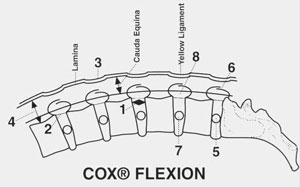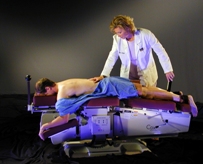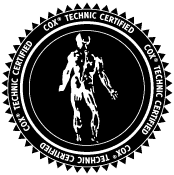"Doc, it would feel good to just be pulled apart!"
Young and old alike experience days when it would feel good to just be pulled apart. This may be an unsophisticated explanation of the effects of chiropractic spinal manipulation at Johnson Chiropractic, where gentle flexion-distraction and decompression is offered, but patients swear by it!

One of our exceptional treatment approaches at Richmond is Cox Technic, a treatment combining axial distraction, flexion, and lateral flexion to reduce pain and return motion to the spine. Gudavalli (1) explains flexion distraction as using combined loads of traction and flexion to a particular lumbar motion segment. Researchers document the effects these motions have on the spine:
- Traction reduces disc herniations. (2)
- Axial distraction decreases annulus and nucleus stresses, fiber stresses, annulus radial bulging, and nucleus radial displacement. (3)
- Flexion increases the spinal canal care by 19% while extension decreases the area by 23%. (4)
- Flexion increases the spinal canal area and decreases pain symptoms. (5)
- Specifically for flexion-distraction, Gudavalli (1) reports that the intervertebral foramen increases
- 28% in spinal canal area,
- 17% in height,
- 7% in width.

If you find yourself thinking "it would feel good if someone would just pull me apart," contact Johnson Chiropractic to do it for you gently, safely and effectively in a doctor-controlled environment.
- Gudavalli MR: Estimation of dimensional changes in the lumbar intervertebral foramen of lumbar spine during flexion distraction procedure. Proceedings of the 1994 International Conference on spinal manipulation, June 10-11, 1994, Palm Springs, California, p. 81
- Onel D et al: Computed tomographic investigation of the effect of traction on lumbar disc herniations. SPINE 14(1)
- Hussain, M; Gay, RE; An, KN. Reduction in disk and fiber stresses by axial distraction is higher in cervical disk with fibers oriented toward the vertical rather than horizontal plane: a finite element model analysis. Journal Of Manipulative And Physiological Therapeutics 2010;33 (4):252-260
- Schmid MR: Changes in cross sectional measurements of the spinal canal and intervertebral foramina as a function of body position: in vivo studies on an open-configuration MR system. AJR 1999;172
- Dia Liyang D: The effect of flexion-extension motion of the lumbar spine on the capacity of the spinal canal: an experimental study. Spine 14(5)
- Ndetan, H, Rupert R, Bae S, Singh, K: Prevalence of musculoskeletal injuries sustained by students while attending a chiropractic college. Journal of Manipulative and Physiological Therapeutics 2009;32(2):140-48

